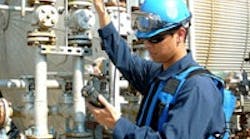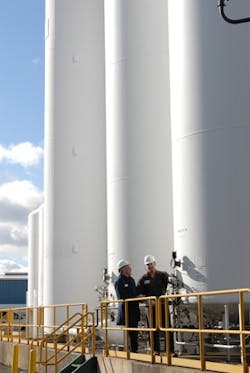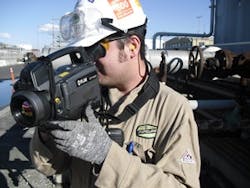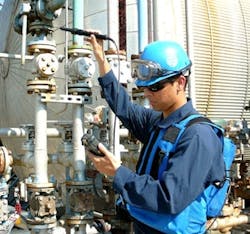The quest to reduce fugitive emissions has taken on new urgency at many sites. This reflects increased attention to operational issues, such as product purity and losses, as well as demands by the U.S. Environmental Protection Agency (EPA), Washington, D.C., for more stringent leak detection and repair (LDAR) strategies.
One company that has successfully lowered leaks is Air Products & Chemicals, Allentown, Pa. It has achieved significant reductions at its two plants that manufacture nitrogen trifluoride (NF3) — in Hometown, Pa., and Ulsan, South Korea. The chemical, which is classified as a greenhouse gas (GHG), mainly is used for cleaning chemical-vapor-deposition chambers for making liquid crystal displays and thin-film solar cells.
Because of the purity demanded by users, leak tightness figured significantly in the design of the NF3 manufacturing process. It features welded systems, bellows valves, diaphragm compressors and sealess pumps to minimize leaks. However, despite the stringent design standards, leak points still existed — so, the company initiated a project to identify them.
"The initial scope of the project was to identify operator actions, through observation and interviews, in order to understand why and how product was being lost, especially during startup, shutdown and upset conditions. The 'non-optimal' operating conditions were noted, and a program was put in place to document and calculate the amount of product which was released," explains Jim Kourpas, global plant process engineering manager.
Air Products relied on a straightforward approach: track times when the units were operating but not producing product, in other words, stable operations, and calculate the amount of product lost. This led to modifications in the work process, simplifying the operators' actions as well as reducing vent losses through automation and reprocessing. The project halved NF3 leakage to approximately 2% of total production.
However, the company wanted to cut leakage to 0.5% and, thus, initiated a further project. "Ideas were generated, further focusing on vent abatement and reclamation. The entire process was again evaluated from production down to the supporting systems. There was debate as to the location of where this next opportunity occurred, in what parts of the process and utility systems this remaining inefficiency existed. Plant engineers performed detailed sensitivity studies of each plant area to arrive at an estimate of the losses with a high confidence of accuracy," says Kourpas.
As part of this detailed evaluation, the engineers looked at every unit operation in the NF3 process, performing an energy and material balance for each. The idea was to close the balance around the entire process from raw material feed to final product. The leak volumes determined via the energy and material balances closely matched those calculated from the amount of product lost during "non-optimal" operating conditions. "This helped us pinpoint product losses through some other previously unexamined leak points like our in-process analytical systems. This also revealed there was a significant margin improvement opportunity by conserving product," he notes.
The overall evaluation also considered fugitive emissions. A research and development team assisted in creating a series of analytical tests around the facility to determine if something was missed in closing the mass balance.
In certain areas of the facility, particularly around rotating equipment such as compressors and near the reactors and loading areas, air monitoring instruments recorded fugitive emissions (Figure 1). Checking that compressors were leak-tight became a part of routine maintenance, as did monitoring piping around the machinery for vibration, which could result in additional leak points at certain piping-to-equipment connections.
"It is important to note that when you are trying to detect process leaks at these extraordinarily low values, even wind direction can be an important factor. The tests were repeated over a range of different environmental conditions, including time of day and various ventilation conditions," Kourpas adds.
Today, the Hometown plant reviews NF3 emissions monthly to ensure its GHG target is achieved. In addition, periodic fugitive emission testing will occur — perhaps annually at first, with data collected determining the frequency going forward.
The Ulsan facility has started a similar GHG reduction program in the past fiscal year, particularly to help prevent venting losses.
On a broader level, Air Products has implemented LDAR programs at multiple locations in the U.S. to comply with several different regulatory requirements. "In almost all cases, we partner with outside LDAR service contractors who are typically selected locally at the site level. We believe this to be the most successful approach in terms of performing the actual monitoring activities themselves, maintenance of leak inspection records in suitable databases, and preparation of necessary reports," says a spokesman.
ANOTHER CORPORATE INITIATIVE
Meanwhile, Solvay, Brussels, Belgium, has integrated its own emissions control strategies with those inherited from Rhodia following its 2011 takeover of that company.
"Sites located in countries where leak detection is regulated such as the U.S. and Europe and most of the big sites handling volatile compounds already report solid quantitative data regarding their fugitive emissions. The plan is to bring all sites to the same standards is terms of leakage rate assessment," says Solvay environmental expert Laurent Sapet.
The company has identified valve stems, flange and reactor gaskets, relief valves, rupture disks and loading/unloading arms as areas for specific focus.
"The strategy is to promote leak detection and repair on all sites and, in particular, those handling volatile and dangerous product such as substances of very high concern as defined in the European REACH directive. Our industrial department is already providing support to those sites willing to start an initiative in this field. It is planned to build a corporate policy supported by group guidance within the next two years," Sapet notes. The initiative could involve a global contract with specific suppliers for leak detection and repair, he adds.
REGULATORY DRIVER
Moves by the EPA are prompting other companies to act. Most recently, in a June 27 consent decree, EPA got BASF, Florham Park, N.J., to revise the emissions strategy for its Wyandotte, Mich., plant.
"BASF is working cooperatively with U.S. EPA to continuously reduce the instances of leaking equipment subject to LDAR requirements. This process is commonly referred to as an enhanced LDAR program. These efforts include preventive maintenance practices, ensuring that equipment is properly specified for the expected service and monitoring for leak-free performance," says a spokesman at BASF's global headquarters in Ludwigshafen, Germany. "BASF is currently working with its third-party supplier to implement and manage the program," he adds.
One person who has been taking a keen interest in the evolution of LDARs is Jim Drago, senior manager, market intelligence, Garlock, Palmyra, N.Y. He says EPA's July 31, 2009, settlement with the Lanxess/Ineos facility in Addyston, Ohio, is the first example of the agency demanding an enhanced LDAR.
"Enhanced LDAR is being imposed when existing LDAR is found not to be working effectively. The most progressive part of an enhanced LDAR program is the demand to use low-leak valves and packings: 100 ppm — as opposed to current 500 ppm — for five years, plus a guarantee and test report from the manufacturer to ensure the target is being met," he notes.
He also has noticed that recent decrees focus particularly on quality programs, repair timing and management of change — although a typical enhanced LDAR program has 14 elements, including: monitoring frequency; leak detection and repair action levels; leak repairs; equipment upgrades, replacement and improvement; training; record keeping; and reporting.
ROLE FOR INFRARED
Drago adds that infrared (IR) cameras (Figure 2) now are accepted as tools to find leaks, in addition to EPA-Method-21 organic vapor analyzers (Figure 3) that were first specified for use in supplemental environmental programs (SEPs) in the late 1990s. "Lo and behold, just over a decade later and they are law, part of standard regulations as an alternative to sniffing. The point here is that they started out as being included in consent decrees, but are now — with time and use — simply part of 'business as usual.'"
One company making good use of IR cameras is LyondellBasell, Houston, which deploys such cameras at its sites in Channelview and La Porte, Texas, and Morris and Tuscola, Ill. The firm adopted the IR camera technology after it proved very effective in ground and aerial surveys.
"The use of IR cameras has enabled us to pinpoint the exact location of leaks that might have remained hidden using traditional fugitive monitoring techniques. In only minutes, an operator can aim, pan and zoom as far as several hundred feet away from an area and check for leaks without leaving his feet. Traditional methods for identifying fugitive emissions required placement of an instrument probe directly on the component, a challenge for components high in a pipe rack," notes the company.
Another advantage of IR cameras is their ability to detect particularly elusive emissions that come from corrosion beneath insulation. Historically, it's been challenging, if not impossible, to pinpoint these leaks because the vapors often exit a considerable distance from the source. The IR camera very easily can detect the source by simply following the trail of the plume.
ConocoPhillips Canada, Calgary, also is a fan of IR. The company, which claims to be the first Canadian firm to use an IR camera to detect fugitive emissions in upstream oil and gas facilities, says the technology rapidly, accurately and safely identifies hydrocarbon gas emissions in realtime: "This has a much higher degree of accuracy compared to conventional methods and has proven to be a cost-effective, efficient and successful method of reducing fugitive emissions," it says.
FENCELINE MONITORING
Drago foresees this possibly becoming another standard technology. "The first demand for fenceline monitoring that I came across was the September 2010 Murphy Oil consent decree when they had to install a similar system as part of a SEP. Maybe in another ten years it will be routine that every site in the U.S. could be required to do the same thing. ConocoPhillips has been routinely using one at its Rodeo refinery near San Francisco for many years. (Its emissions can be seen at http://fenceline.net/fence.php.)"
EPA's May 23, 2012, consent decree with BP North America, Houston, to cut emissions from its Whiting, Ind., refinery requires installation of a fenceline monitoring system as well as publishing the data live on a website.
As a result of LDAR and enhanced LDAR, chemical makers are asking Garlock to provide "best in class" sealing solutions — including product recommendations, training and on-site troubleshooting/failure analysis where required. "In an LDAR program, especially if a chemical plant is given a consent decree, they want training not only for their employees but also for the contractors and valve installers. In gasketing GST is called constantly for consulting."
Garlock's customers are focusing particularly on fugitive emissions from valve stem packing. Some, for instance, are looking into upgrading valve technology for lines carrying high priority volatile organic compounds such as benzene. Emissions from flanges, despite the large numbers of them at most sites, don't seem to be a major problem.
"When we started working on LDAR programs back in 2001, we were repacking all valves in the field that had readings of over 500 ppm. All the new valves that were in the storage yard were sent to a staging area for repack with Garlock low-emission packing. What we see now is that 80% of valves that are chronic leakers or problem valves are being replaced with new valves with low-leak packing," notes Drago.
Seán Ottewell is Chemical Processing's Editor at Large. You can e-mail him at [email protected]





